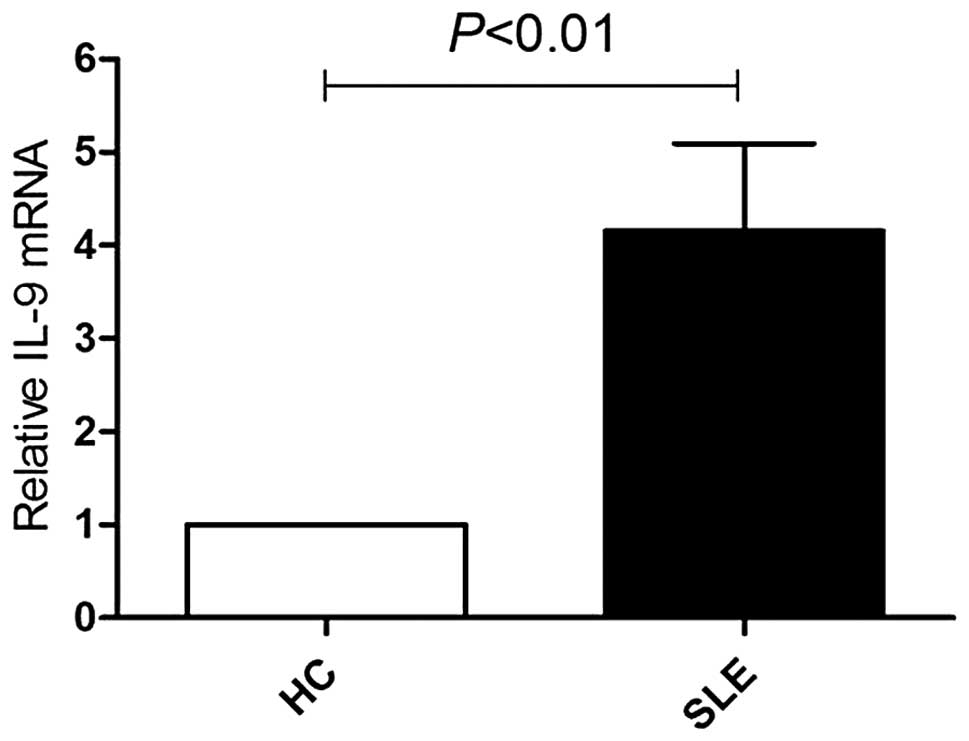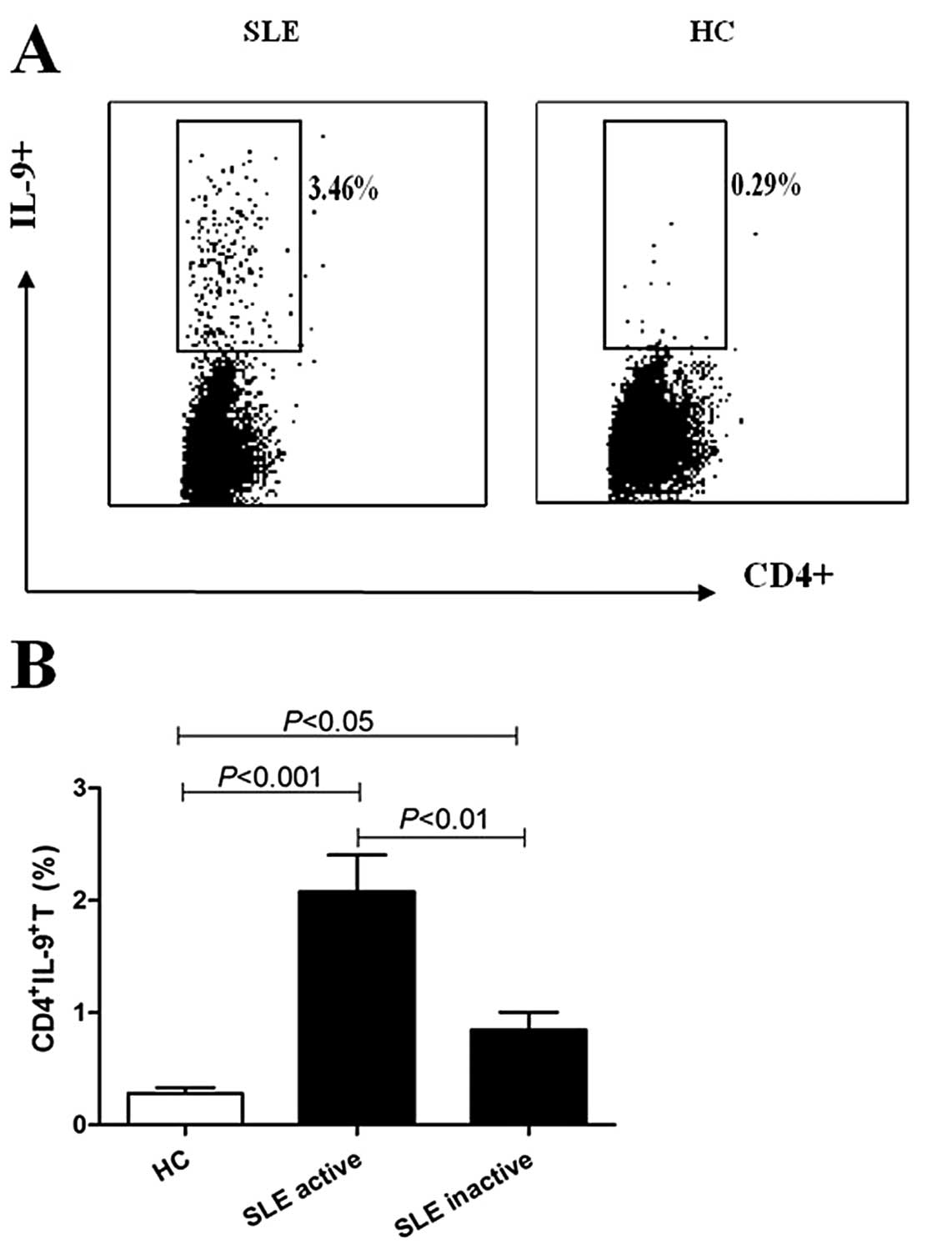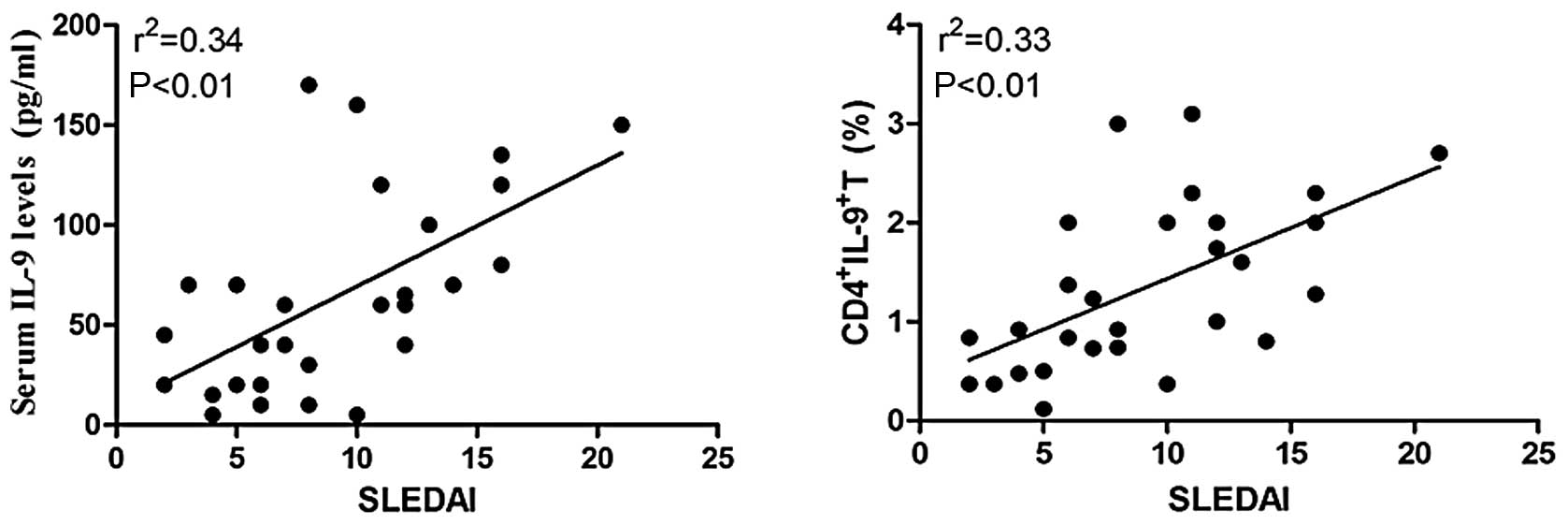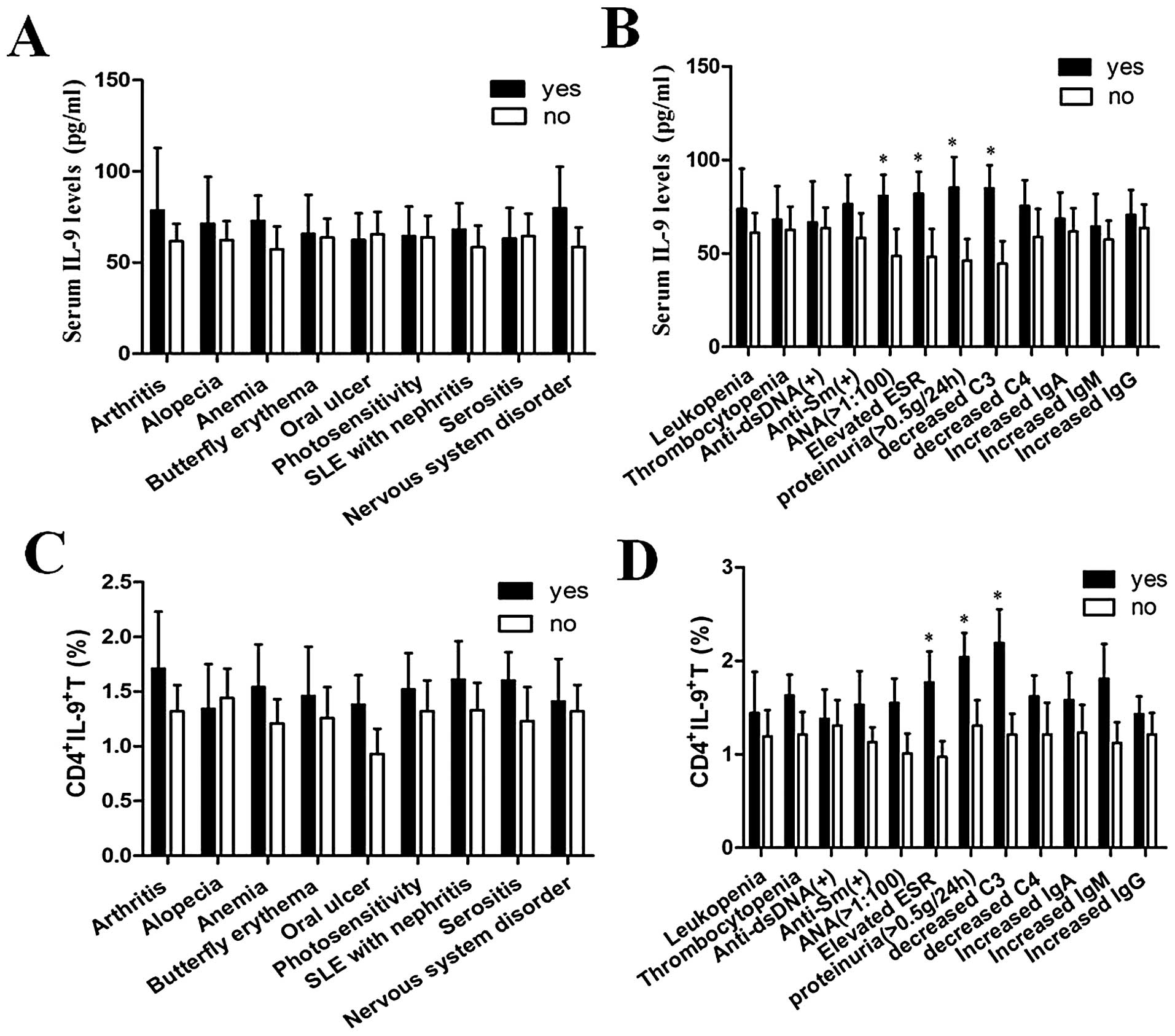Increased interleukin‑9 and CD4+IL-9+ T cells in patients with systemic lupus erythematosus
- Authors:
- Published online on: January 2, 2013 https://doi.org/10.3892/mmr.2013.1258
- Pages: 1031-1037
Abstract
Introduction
Systemic lupus erythematosus (SLE) is an autoimmune disease in which almost all the organ systems, including the skin, kidneys, lungs, brain, heart and joints, are damaged (1). However, the precise mechanism of SLE has not been fully elucidated. Previous studies show that SLE is primarily caused by high levels of autoantibodies which are generated by enhanced apoptosis in conjunction with defective clearance of apoptotic cells (2) and immune complex deposition. Although the pathogenesis of SLE remains unclear, many studies have suggested that cytokines or growth factors are considered to play an important role in SLE. Deregulated cytokine production is known to contribute to immune dysfunction as well as to mediate tissue inflammation and organ damage. Cytokines produced by abnormal T helper (TH) cells have been shown to be implicated in the pathogenesis of SLE (3).
IL-9 is a T cell-derived cytokine that is initially designated a Th2 cytokine (4). Recently, Tregs, Th1, Th17 and Th9 subsets of T cells were also found to produce IL-9 (5–8). It has been reported that IL-9 causes pleiotropic effects in these subsets (7), and that it plays different roles in different situations in regulating immune responses. IL-9 targets cells of the lymphoid, myeloid and mast cell lineages, and is likely to contribute to the development of allergic (9) and autoimmune diseases (10) such as asthma, arthritis, multiple sclerosis and experimental autoimmune encephalomyelitis (EAE).
However, whether abnormal expression and secretion of IL-9 are present in SLE patients still remains unknown, and it is also unclear whether IL-9 exerts main proinflammatory or anti-inflammatory activities in SLE. Therefore, in the present study, the expression of IL-9 levels and the percentages of CD4+IL-9+ T cells in SLE patients as well as their association with disease manifestations and activity were investigated, in order to provide a better understanding of the interrelationship and immunopathological roles of IL-9 in SLE.
Materials and methods
Subjects
Peripheral blood samples were obtained from 28 SLE patients from the Second Affiliated Hospital of Soochow University (Suzhou, China), including 13 active (12 females, 1 male; mean age, 36±12 years) and 15 inactive SLE patients (15 females, 0 male; mean age, 34±11 years), excluding those with a current infection. Eight patients were not administered any immuno-modulating medication at the time of analysis. Control samples were collected from 12 healthy volunteers (10 females, 2 males; mean age, 31±7 years), none of which suffered from any rheumatologic diseases. The diagnosis of SLE was established by the presence of ≥4 American College of Rheumatology (ACR) diagnostic criteria (11). Active SLE was defined as a SLE disease activity index (SLEDAI) score ≥10, while patients with SLEDAI <10 were evaluated as inactive (12). Patient clinical and demographic characteristics are presented in Table I. The processes involved in the present study as well as informed consent forms were approved by the respective institutions.
Sample preparation and cell cultures
Blood samples were collected in vacutainer tubes containing ethylenediaminetetraacetic acid (EDTA). Following the collection of peripheral blood samples, reserve serum and peripheral blood mononuclear cells (PBMCs) were isolated by centrifugation against a density gradient, and the enriched cells were removed from the density medium:plasma interface. The samples were washed two times with phosphate-buffered saline (PBS); part of the collected cells was used for RNA extraction. Isolated PBMCs (1×106 in 1.5 ml of RPMI-1640) for intracellular staining were stimulated for 6 h with PMA (50 ng/ml) (Sigma-Aldrich, St. Louis, MO, USA) and ionomycin (500 ng/ml; Sigma-Aldrich). Four hours prior to collection, brefeldin A (GolgiPlug™, 1 μl/ml; BD Pharmingen, Franklin Lakes, NJ, USA) was added to the cell culture, along with PMA and ionomycin. The cells were fixed and permeabilized (Fix/Perm; eBioscience, San Diego, CA, USA) according to the manufacturer’s instructions, and were incubated at room temperature with formaldehyde.
RNA extraction and real-time PCR analysis
RNA was isolated using TRIzol reagent, followed by reverse transcription using M-MLV reverse transcriptase and oligo(dT) primer (Invitrogen, Carlsbad, CA, USA). Approximately 1.5 μg RNA was converted to cDNA. For measuring the mRNA levels of IL-9 and glyceraldehyde-3-phosphate dehydrogenase (GAPDH), 1 μl cDNA in triplicate was used for amplification by the TaqMan RT-PCR system (ABI Prism 7900HT Sequence Detection System; Applied Biosystems, Foster City, CA, USA) with specific TaqMan primers. Amplification was performed using standard conditions and calculations of fold induction were performed. Gene expression was normalized to GAPDH and the values were expressed relative to control using the ΔΔCT method. The primers used included: IL-9 sense, 5′-GTGCCACTGCAGTGCTAATGT-3′ and anti-sense, 5′CTCTCACTAAGCATGGTCTGG-3′; GAPDH sense, 5′-AT CCCATCACCATCTTCCAG-3′ and anti-sense, 5′-GAGTC CTTCCACGATACCAA-3′.
Measurement of serum IL-9 levels
Venous blood samples were collected into into pyogen-free blood collection tubes, immediately immersed in melting ice, and allowed to clot 1 h prior to centrifugation. All the serum samples were stored at −80°C before use. All the procedures used were standardized. Serum IL-9 levels were measured using specific ELISA kits (R&D Systems, Minneapolis, MN, USA). Each sample was tested in duplicate. The results were expressed as pg/ml and the detection limit of this assay was 0.5 pg/ml.
Flow cytometric analysis
The enriched cells were stained with the anti-CD4 Alexa Fluor 488 antibody (eBioscience) for purity checking. Intracellular staining was performed using anti-IL-9-PE (eBioscience). The percentages of cytokine-secreting CD4+IL-9+ T cells were determined by flow cytometry using a FACSCalibur instrument (Becton-Dickinson, Franklin Lakes, NJ, USA).
Clinical and laboratory parameters
Part of clinical manifestations of SLE patients were defined as follows: renal involvement (proteinuria >0.5 g/24 h, presence of cellular casts, hematuria with >10 red blood cells/hpf excluding infection or stone, >5 leukocytes/hpf excluding infection, or plasma creatinine >1.4 mg%), arthritis (non-erosive arthritis affecting ≥2 peripheral joints), nervous system disorder (psychosis, seizure, depression and peripheral neuropathy). Laboratory abnormalities were recorded, including leukopenia (white blood cell count <4,000/mm3), thrombocytopenia (platelet count <100,000/mm3), elevated erythrocyte sedimentation rate (>20 mm/h), the presence of anti-dsDNA, antinuclear, anti-Sm (by indirect immunofluorescence), IgG, IgA, IgM and serum levels of C3, C4 and 24-hour urinary protein (by immunoturbidimetry).
Statistical analysis
Results were expressed as the means ± standard deviation (SD). Statistical analysis of the data was performed using the GraphPad Prism (Version 4.0) statistical program. The nonparametric Mann-Whitney U test was used to compare data between SLE patients and healthy controls. Analysis of covariance was used to compare data among three groups. The association of the data with clinical and laboratory parameters of SLE patients was analyzed using the independent samples t-test. For the correlation analysis with SLEDAI, Pearson correlation coefficient was used. Repeated measurement ANOVA was used to compare the parameters before and after treatment. Two-sided P-values <0.05 were considered to indicate a statistically significant difference.
Results
IL-9 mRNA expression is increased in SLE patients
In order to examine whether the expression of IL-9 is altered in SLE patients, real-time PCR was used to detect the mRNA levels of IL-9 from single nuclear PBMCs from the peripheral blood of SLE patients (n=28) and healthy controls (n=12). The results showed that IL-9 mRNA in SLE patients was significantly higher compared with that in healthy controls (P<0.01, two groups of comparisons) (Fig. 1).
Serum IL-9 levels are increased in SLE patients
Next, to define the abnormality of IL-9 protein expression in the peripheral blood of SLE patients, we tested the serum IL-9 levels in the fresh serum of the peripheral blood samples of SLE patients. It was found that serum IL-9 levels were significantly higher in active and inactive SLE patients compared with the healthy controls (72.3±16.7 vs. 26.3±6.4 pg/ml, P<0.01; 56.7±11.5 vs. 26.3±6.4 pg/ml, P<0.05) (Fig. 2). However, there was no significant difference between 8 untreated SLE patients and 5 active SLE patients, to whom treatment with a small amount of immunodepressant was administered prior to relapse (P>0.05).
Increased percentages of CD4+IL-9+ T cells in SLE patients
The percentages of CD4+IL-9+ T cells in SLE patients were analyzed using flow cytometry. Results showed that the percentages of CD4+IL-9+ T cells were increased in active and inactive SLE patients compared with healthy controls (2.11±0.26 vs. 0.28±0.05%, P<0.001; 0.86±0.16 vs. 0.28±0.05%, P<0.05), while it was higher in active compared with inactive SLE patients (2.11±0.26 vs. 0.86±0.16%, P<0.01) (Fig. 3). The percentages of CD4+IL-9+ T cells in 8 untreated active SLE patients were moderately higher compared with 5 active SLE patients who were administered treatment with immunodepressant (P>0.05, two groups of comparisons).
Association of serum IL-9 levels and percentages of CD4+IL-9+ T cells with the clinical features of SLE patients
To determine whether IL-9 expression and the percentages of CD4+IL-9+ T cells were associated with disease activity, it was observed that the percentages of CD4+IL-9+ T cells and the serum IL-9 levels were correlated with SLEDAI. The results showed that both the percentages of CD4+IL-9+ T cells and the serum levels of IL-9 were positively associated with SLEDAI (Fig. 4). Additionally, potential association of serum IL-9 levels and the percentages of CD4+IL-9+ T cells with major clinical features of SLE patients was analyzed, but no correlation was found (Fig. 5).
Association of serum IL-9 levels and the percentages of CD4+IL-9+ T cells with the laboratory parameters of SLE patients
In order to analyze the relation between the expression of IL-9 and the laboratory parameters of SLE patients, we correlated serum IL-9 levels and the percentages of CD4+IL-9+ T cells with certain laboratory parameters. The results showed that serum IL-9 levels were significantly increased in SLE patients with decreased C3, increased ANA, elevated ESR and high proteinuria (P<0.05 for each). The percentages of CD4+IL-9+ T cells were also significantly increased in SLE patients with decreased C3, elevated ESR and high proteinuria (P<0.05 for each). However, there was no significant difference between the expression of IL-9 and other laboratory parameters (Fig. 5).
Glucocorticoid influence on serum IL-9 levels and the percentages of CD4+IL-9+ T cells
Finally, in order to explore the effect of glucocorticoids on serum IL-9 levels and the percentages of CD4+IL-9+ T cells, 8 active SLE patients who were not administered any immuno-modulating medication were assessed. Notably, the percentages of CD4+IL-9+ T cells and the protein levels of IL-9 in the 8 untreated active SLE patients gradually decreased l, 2 and 3 weeks following treatment with methylprednisolone (0.8 mg/kg/day) when compared with those prior to treatment (Fig. 6).
Discussion
According to Nowak et al(13), IL-9 receptor deficiency attenuates EAE disease, indicating that IL-9 is correlated with EAE. Poulin et al(14) found that IL-9 mRNA and protein were highly expressed in a mouse model of fully mismatched heart transplantation. A previous study also demonstrated that serum levels of IL-9 and additional pathologic cytokines were elevated after the second immunization of rheumatoid arthritis (RA) (15), while Khan et al(16) further confirmed that IL-9 and some another inflammatory cytokines were descended following treatment with rituximab, indicating that IL-9 plays a pro-inflammatory role in RA. Additional evidence indicates that IL-9 cytokine may contribute to the development of autoimmune diseases.
To elucidate whether IL-9 expression is abnormal in the peripheral blood of SLE patients, IL-9 mRNA expression level and serum IL-9 levels were analyzed in SLE patients and healthy controls. The results of the present study indicate that IL-9 production was significantly increased in SLE patients compared with healthy controls. IL-9 production was also significanlty increased in active SLE patients, indicating that the elevation of IL-9 levels may trigger the inflammatory process in SLE.
Previous studies have shown that CD4+ T cell subsets, including Tregs, Th1, Th2, Th17 and Th9, produce IL-9 under specific conditions. In the present study, the percentages of IL-9 expression in CD4+ T cells were analyzed using flow cytometry. It was found that the percentages of CD4+IL-9+ T cells from the peripheral blood of active and inactive SLE patients were significantly increased compared with the healthy controls, suggesting that CD4+IL-9+ T cells may play an important role in the pathogenesis of SLE. In the present study, it was shown that the percentages of CD4+IL-9+ T cells were significantly increased; however, the question of which subset of the CD4+ T cells was the major contributor still remains to be elucidated. There is controversial evidence concerning the subtype of T cells producing this cytokine, which include but are not limited to Th1, Th2, Th9, Th17 and Treg cells.
In the present study, a strong positive correlation between the percentages of CD4+IL-9+ T cells and SLEDAI in SLE patients was found, while the similar correlation was found between serum IL-9 levels and SLEDAI. Additionally, serum IL-9 levels were significantly increased in SLE patients with decreased C3, increased ANA, elevated ESR and high proteinuria. Similarly, the percentages of CD4+IL-9+ T cells were significantly increased in SLE patients with decreased C3, elevated ESR and high proteinuria, indicating that the percentages of CD4+IL-9+ T cells and serum IL-9 levels are correlated with disease activity and severity. The percentages of CD4+IL-9+ T cells and serum IL-9 levels tended to be higher in patients with leukopenia, thrombocytopenia, increased immunoglobulin, as well as patients positive for anti-dsDNA and anti-Sm. Nevertheless, a significant difference was not reached. Moreover, the percentages of CD4+IL-9+ T cells and serum IL-9 were not significantly increased in SLE patients with the typical clinical features of SLE compared with patients without the clinical features (Fig. 5). This was probably due to the low number of the patients included, or due to the heterogeneity of SLE patients. Further studies are needed to confirm these preliminary results. In the present study, an influence of treatment on the percentages of CD4+IL-9+ T cells and serum IL-9 levels was not found between untreated active SLE and those active SLE who were administered treatment with immunodepressant prior to relapse.
Glucocorticoids affect cytokine synthesis in T cells by binding to and activating cytoplasmic glucocorticoid receptors which translocate to the nucleus and regulate the transcription of target genes. Brink et al(17) reported that even low doses of steroids inhibit cytokine synthesis in SLE patients. Similarly, in the present study, the effects of glucocorticoids on serum IL-9 levels and CD4+IL-9+ T cells in SLE patients were investigated. Notably, the percentages of CD4+IL-9+ T cells and the protein levels of IL-9 in 8 untreated active SLE patients were gradually decreased l, 2 and 3 weeks after treatment with methylprednisolone, indicating that glucocorticoids downregulate the expression of IL-9 and IL-9-producing CD4+ T cells in SLE patients. These results suggest that the abnormality of IL-9 and CD4+IL-9+ T cells may play a role in the inflammatory process of SLE.
The pro-inflammatory role of IL-9 in SLE patients may be related to Th17 cells. It has been recently shown that IL-9, as a dominant cytokine, is produced by Th17 cells (18). Th17 cells produce large quantities of IL-9 which, in turn, further amplify Th17 cells which have been shown to be an important subset in human autoimmune diseases, including RA (16), multiple sclerosis (19) and SLE (3). Additionally, there is evidence suggesting that IL-9 production in Th17 cells is pathogenic during autoimmunity. According to Beriou et al(20), it has been suggested that the Th17 population in patients with type 1 diabetes have an increased propensity to secrete IL-9. IL-9R deficiency has been shown to attenuate EAE disease and to have a decreased accumulation of Th17 cells in a mouse model, indicating that IL-9 is pathogenic in autoimmunity (10). However, there has been a number of studies showing an anti-inflammatory activity of IL-9 in human autoimmune diseases (18,21), potentially due to the fact that IL-9 enhances the suppressive function of regulatory T cells (18). Thus, the functions and mechanisms of IL-9 in SLE as well as additional autoimmune diseases remains to be elucidated.
In conclusion, the present study demonstrated increased mRNA levels of IL-9, serum IL-9 levels and percentages of CD4+IL-9+ T cells in SLE patients, particularly inactive SLE, which were correlated with disease activity and severity. Thus, IL-9 and CD4+IL-9+ T cells might play an impotrant role in SLE. Finally, treatment with a high-dose of methylprednisolone was demonstrated to reduce serum IL-9 levels and the percentages of CD4+IL-9+ T cells, indicating that IL-9 and CD4+IL-9+ T cells are involved in the inflammatory process of SLE. The use of IL-9-specific antibodies in the treatment of several conditions, such as EAE (13), collagen-induced arthritis (14), transplantation (22), chronic active EBV infection (23) and human anaplastic large-cell lymphoma cells (24), has been previously implemented. Targeting IL-9 in human SLE could be a promising approach in the future. Therefore, further studies are needed confirm and extend the current results.
Acknowledgements
This study was partly supported by the National Natural Science Foundation of China (grant no. 81200507) and the Natural Science Foundation of Jiangsu Province (grant no. SBK201121707).
References
|
Rahman A and Isenberg DA: Systemic lupus erythematosus. N Engl J Med. 358:929–939. 2008. View Article : Google Scholar | |
|
Herrmann M, Voll RE and Kalden JR: Etiopathogenesis of systemic lupus erythematosus. Immunol Today. 9:424–426. 2000. View Article : Google Scholar | |
|
Pan HF, Ye DQ and Li XP: Type 17 T-helper cells might be a promising therapeutic target for systemic lupus erythematosus. Nat Clin Pract Rheumatol. 4:352–353. 2008.PubMed/NCBI | |
|
Knoops L and Renauld JC: IL-9 and its receptor: from signal transduction to tumorigenesis. Growth Factors. 22:207–215. 2004. View Article : Google Scholar : PubMed/NCBI | |
|
Liu Y, Teige I, Birnir B, et al: Neuron-mediated generation of regulatory T cells from encephalitogenic T cells suppresses EAE. Nat Med. 12:518–525. 2006. View Article : Google Scholar : PubMed/NCBI | |
|
Sugimoto T, Ishikawa Y, Yoshimoto T, et al: Interleukin 18 acts on memory T helper cells type 1 to induce airway inflammation and hyperresponsiveness in a naive host mouse. J Exp Med. 199:535–545. 2004. View Article : Google Scholar : PubMed/NCBI | |
|
Elyaman W, Bradshaw EM, Uyttenhove C, et al: IL-9 induces differentiation of TH17 cells and enhances function of FoxP3+ natural regulatory T cells. Proc Natl Acad Sci USA. 106:885–890. 2009. View Article : Google Scholar : PubMed/NCBI | |
|
Jager A, Dardalhon V, Sobel RA, et al: Th1, Th17 and Th9 effector cells induce experimental autoimmune encephalomyelitis with different pathological phenotypes. J Immunol. 183:7169–7177. 2009. View Article : Google Scholar : PubMed/NCBI | |
|
Soroosh P and Doherty TA: Th9 and allergic disease. Immunology. 127:450–458. 2009. View Article : Google Scholar : PubMed/NCBI | |
|
Nowak EC and Noelle RJ: Interleukin-9 as a T helper type 17 cytokine. Immunology. 131:169–173. 2010. View Article : Google Scholar : PubMed/NCBI | |
|
Tan EM, Cohen AS, Fries JF, et al: The 1982 revised criteria for the classification of systemic lupuserythematosus. Arthritis Rheum. 25:1271–1277. 1982. View Article : Google Scholar : PubMed/NCBI | |
|
Bombardier C, Gladman DD, Urowitz MB, et al: Derivation of the SLEDAI. A disease activity index for lupus patients The Committee on Prognosis Studies in SLE. Arthritis Rheum. 35:630–640. 1992. View Article : Google Scholar : PubMed/NCBI | |
|
Nowak EC, Weaver CT, Turner H, et al: IL-9 as a mediator of Th17-driven inflammatory disease. J Exp Med. 206:1653–1660. 2009. View Article : Google Scholar : PubMed/NCBI | |
|
Poulin LF, Richard M, Le Moine A, et al: Interleukin-9 promotes eosinophilic rejection of mouse heart allografts. Transplantation. 76:572–577. 2003. View Article : Google Scholar : PubMed/NCBI | |
|
Tsuji F, Yoshimi M, Katsuta O, et al: Point mutation of tyrosine 759 of the IL-6 family cytokine receptor, gp130, augments collagen-induced arthritis in DBA/1J mice. BMC Musculoskelet Disord. 10:232009. View Article : Google Scholar : PubMed/NCBI | |
|
Khan IH, Krishnan VV, Ziman M, et al: A comparison of multiplex suspension array large-panel kits for profiling cytokines and chemokines in rheumatoid arthritis patients. Cytometry B Clin Cytom. 76:159–168. 2009. View Article : Google Scholar : PubMed/NCBI | |
|
Brink I, Thiele B, Burmester GR, et al: Effects of anti-CD4 antibodies on the release of IL-6 and TNF-alpha in whole blood samples from patients with systemic lupus erythematosus. Lupus. 8:723–730. 1999. View Article : Google Scholar : PubMed/NCBI | |
|
Elyaman W, Bradshaw EM, Uyttenhove C, et al: IL-9 induces differentiation of TH17 cells and enhances function of FoxP3+ natural regulatory T cells. Proc Natl Acad Sci USA. 106:12885–12890. 2009. View Article : Google Scholar : PubMed/NCBI | |
|
Tzartos JS, Manuel AF, Matthew JC, et al: Interleukin-17 production in central nervous system-infiltrating T cells and glial cells is associated with active disease in multiple sclerosis. Am J Pathol. 172:146–155. 2008. View Article : Google Scholar : PubMed/NCBI | |
|
Beriou G, Bradshaw EM, Lozano E, et al: TGF-b induces IL-9 production from human Th17 cells. J Immunol. 185:46–54. 2010. View Article : Google Scholar : PubMed/NCBI | |
|
Koichi Y, Ayumi Y, Yoshihide A, et al: Serum interleukin 9 levels are increased in patients with systemic sclerosis: association with lower frequency and severity of pulmonary fibrosis. J Rheumatol. 38:2193–2197. 2011. View Article : Google Scholar : PubMed/NCBI | |
|
Lu LF, Lind EF, Gondek DC, et al: Mast cells are essential intermediaries in regulatory T-cell tolerance. Nature. 442:997–1002. 2006. View Article : Google Scholar : PubMed/NCBI | |
|
Yang L, Aozasa K, Oshimi K, et al: Epstein-Barr virus (EBV) encoded RNA promotes growth of EBV-infected T cells through interleukin-9 induction. Cancer Res. 64:5332–5337. 2004. View Article : Google Scholar : PubMed/NCBI | |
|
Qiu L, Lai R, Lin Q, et al: Autocrine release of interleukin-9 promotes Jak3-dependent survival of ALK+ anaplastic large-cell lymphoma cells. Blood. 108:2407–2415. 2006. View Article : Google Scholar : PubMed/NCBI |















